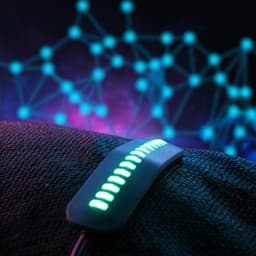
Engineering and Technology
Eye tracking and eye expression decoding based on transparent, flexible and ultra-persistent electrostatic interface
Y. Shi, P. Yang, et al.
Discover the revolutionary electrostatic sensing interface designed for active eye-tracking systems by Yuxiang Shi, Peng Yang, Rui Lei, Zhaoqi Liu, Xuanyi Dong, Xinglin Tao, Xiangcheng Chu, Zhong Lin Wang, and Xiangyu Chen. This innovative technology enables precise detection of eye movements with an impressive 5° angular resolution, opening doors for real-time human-computer interaction and consumer preference analysis.
~3 min • Beginner • English
Introduction
The study addresses the need for non-contact, portable, and reliable eye-tracking methods by leveraging an electrostatic induction-based active eye-tracking (AET) system. Conventional approaches such as scleral search coils, MR-based trackers, video oculography, and electrooculography (EOG) have drawbacks including invasiveness, bulky equipment, privacy concerns, placement constraints, and discomfort or infection risks from contact electrodes. The authors propose a transparent, flexible, glasses-mounted electrostatic sensing interface that actively detects periocular skin/eyelash movements induced by eye rotations and blinks. The research goal is to enhance charge storage and stability to achieve high sensitivity and persistence for real-time decoding of eye movements, gaze tracking, and eye-controlled human-computer interaction.
Literature Review
The paper reviews prior eye-tracking methods: scleral search coils (invasive and prone to slippage), MR-based tracking (accurate but cumbersome and non-portable), video oculography (high resolution but privacy and placement concerns), and EOG (theoretically high resolution but limited breathability and infection risk due to contact electrodes like Ag/AgCl). It also surveys triboelectric nanogenerator (TENG)-based wearable sensors, which have low cost, high sensitivity, and multi-mode operation, and have been used in gesture recognition, motion mapping, and communication. The authors highlight the potential for TENG-based electrostatic sensors to enable non-contact eye tracking by detecting variations in electrostatic fields around pre-charged dielectrics.
Methodology
Device design: A transparent, flexible electrostatic sensing interface with a triple-layer structure comprising a composite dielectric bilayer (S-PCTFE grafted onto PDMS) and a rough-surface Ag nanowire (Ag NWs) electrode on a PDMS substrate. The final stack is PDMS/Ag NWs/PDMS/S-PCTFE.
Materials selection and optimization: Compared PTFE, PVC, and PCTFE films (20 µm) after corona poling for charge storage capability. Measured transferred charge, surface charge density, initial open-circuit voltage, and charge-keeping rate over 1000 non-contact cycles. Performed DFT calculations of molecular electrostatic potential surfaces and polarizability to interpret charge density and retention differences. Chose PCTFE for highest charge density and optical transparency; used PDMS for flexibility.
Dielectric bilayer fabrication: Addressed cracking and poor retention of sputtered nanolayer PCTFE (S-PCTFE) by grafting S-PCTFE onto benzophenone-treated PDMS (via free radical polymerization during RF magnetron sputtering). Verified via SEM, ATR-FTIR (unsaturated group bands 1650–1750 cm−1), and EDS (thin F layer). Optimized PDMS thickness (15–75 µm); best performance at 20 µm. PCTFE thickness controlled by sputter time (~50 nm/h); performance saturates beyond 2 h sputtering. Achieved initial voltage 22.28 V and charge-keeping 95.92% (1000 cycles) for the bilayer.
Electrode engineering and capacitance enhancement: Pre-etched Ag NWs with serrated bulges using H2O2 in PVP solution (ice bath), followed by washing and ethanol dispersion. The roughened Ag NWs increase inherent capacitance (COMSOL: from 426.71 nF to 472.63 nF for equivalent thickness). PDMS is cured atop the rough Ag NWs to form a tight layered structure. Measured mechanical/electrical stability: surface resistance increased under bending (radius ~3 mm) and stretching (elongation up to 1.2), but with negligible effect on TENG performance due to high matching resistance.
Optical and environmental characterization: UV–Vis transmittance indicates minimal loss in 400–700 nm with added layers; interface remains transparent. Stability tested under humidity, airflow, and temperature: voltage slightly decreases only near ~90% RH; no interference from airflow up to 8.1 m/s; voltage increases during heating to 100.2 °C (from ~22.34 V to ~51.95 V) and returns upon cooling (~27.00 V).
Interface array configuration: Used 3D face scanning to analyze periocular skin/eyelid movement patterns during eye rotations (supraversion/infraversion and dextroversion/laevoversion). Placed four channels around the eye: two vertical (VC1 above, VC2 below) and two horizontal (HC1, HC2) flanking the lower eyelid to maximize sensitivity to skin/eyelash motion. Flexible PDMS substrate adheres to various glasses curvatures; array spacing can be stretched to fit users.
Sensing principle and testing: The pre-charged dielectric induces an electrostatic field; periocular skin/eyelash proximity modulates potential, generating open-circuit voltage signals without contact. Evaluated responses to blinks and eye rotations at multiple angles (5°–40°). Also tested performance after sweating (periocular humidity from ~42.7% to ~71.0%).
Eye tracking and HCI system: Built a real-time gaze tracking setup with a 3×3 grid of targets, camera, and multichannel data acquisition (NI USB-6356), decoding movement directions via deep learning. For gaze direction classification (8 directions including diagonals), used a VGG-based model achieving high accuracy. For command input, implemented a lightweight CNN (three stacked Conv1d+ReLU+BatchNorm blocks and a fully connected layer) to classify 8 eye actions (2, 3, 4 blinks; double 2-second gaze; and four cardinal directions) into mouse commands (left/right/double click, dormant; up/down/left/right movement). Processing latency ~1.002 ms.
Fabrication details: PDMS (SYLGARD184) mixed 15:1 w/w, spin-coated and cured (80 °C, 4 h); O2 plasma treatment (80 sccm). Ag NWs (spray-coated 20 cycles with mask; dried 70 °C, 1 min per cycle). Overcoating PDMS (spin speeds 1–6 krpm to set 75–15 µm), UV benzophenone treatment (10 wt% in ethanol; 365 nm, 1 h), ethanol rinse and N2 dry, followed by PCTFE sputtering (Ar 60 sccm, 60 W, ~50 nm/h) through a mask. Measurements: electrometer (Keithley 6514) for voltage/charge, SEM/EDS, UV–Vis, four-point probe (Keithley 2450; HP-504), AFM, 3D face scanner, dielectric spectrometer, plasma system, sputter deposition, and step meter.
Key Findings
- A triple-layer electrostatic interface (PDMS/Ag NWs/PDMS/S-PCTFE) achieves ultra-persistent charge storage and high sensitivity for non-contact eye tracking.
- Peak electrostatic surface charge density: 1671.10 µC·m−2 with rough Ag NWs and dielectric bilayer; transferred charge 667.78 nC; initial voltage ~24.39 V; charge-keeping rate 96.91% after 1000 non-contact cycles.
- Dielectric material comparison after corona poling: PCTFE shows the highest transferred charge (665.75 nC) and average surface charge density (1642.46 µC·m−2) and highest initial voltage (~24.00 V), outperforming PVC (524.63 nC) and PTFE (207.76 nC). Charge retention over 1000 cycles: PTFE 96.25%, PCTFE 88.65%, PVC 74.85%. DFT indicates PTFE’s better retention (higher electron-withdrawing capability) and PVC’s higher polarizability; PCTFE balances both via C–F and C–Cl groups.
- Single sputtered PCTFE nanolayer (S-PCTFE) suffers cracking, low transferred charge (17.80 nC), low charge density (44.72 µC·m−2), and voltage decay (from 4.31 V to ~half). Grafting S-PCTFE onto benzophenone-treated PDMS yields a smooth, ultrathin dielectric with improved retention: bilayer at 20 µm PDMS shows transferred charge 581.55 nC, average surface charge density 1454.61 µC·m−2, initial voltage 22.28 V, and 95.92% charge retention (1000 cycles). Over 15 days, initial voltage decreases to ~85% of day 1 (18.94 V), while per-cycle retention slightly increases to 99.66%.
- Rough Ag NW electrode increases capacitance (COMSOL: 426.71 nF → 472.63 nF), boosting output without compromising transparency in the visible range (400–700 nm). Electrical resistance increases under bending (radius ~3 mm) and stretching (elongation up to 1.2), but with negligible impact on performance.
- Environmental stability: Stable under humidity up to ~90% RH (slight decrease only near 90%), insensitive to airflow (up to 8.1 m/s). Temperature rise from 44.2 to 100.2 °C increases voltage (~22.34 V to ~51.95 V), then returns (~27.00 V) upon cooling.
- Eye-tracking performance: Distinct multi-channel voltage patterns for blinks and for eye rotations in vertical and horizontal directions; angular resolution of 5°. Stable operation after sweating (periocular RH ~42.7%→~71%). Capable of decoding oculogyria with eyes closed (REM-like patterns).
- Gaze tracking and preference mapping: Real-time decoding of 8 movement directions in a 3×3 grid; deep learning (VGG) achieves high recognition accuracy (reported up to 98% total accuracy), enabling reconstruction of gaze paths and 3D dwell-time/frequency maps.
- Eye-controlled input modality: Lightweight CNN decodes 8 eye actions into mouse commands with 100% test accuracy after 20 epochs; end-to-end processing latency within 1.002 ms. Demonstrated real-time file selection, opening, and copying via eye-only control.
Discussion
The work demonstrates that enhancing inherent capacitance and interfacial trap density via a rough Ag NW electrode and a grafted PCTFE/PDMS dielectric bilayer yields a persistent, high-density electrostatic interface. This enables stable non-contact sensing of periocular skin/eyelash movements tightly coupled to eye rotations and blinks, addressing limitations of conventional methods (invasiveness, bulk, privacy, and contact-induced discomfort). The interface’s transparency, flexibility, and adaptability to different glasses frames improve wearability and portability. The multi-channel array informed by 3D periocular kinematics provides robust signal patterns for different eye movements, enabling accurate real-time decoding using deep learning. The system supports gaze tracking for preference analysis and an eye-controlled HCI with low latency and high accuracy, suggesting utility for assistive technologies (e.g., ALS), VR, and monitoring (e.g., REM sleep). Environmental robustness (humidity, airflow) and beneficial temperature response further support practical deployment.
Conclusion
The study introduces a glasses-integrated, transparent, flexible, and ultra-persistent electrostatic interface that enables a non-contact active eye-tracking system. By combining a grafted PCTFE/PDMS dielectric bilayer with roughened Ag NW electrodes, the device achieves a high surface charge density (1671.10 µC·m−2) and excellent charge retention (96.91% after 1000 cycles), supporting sensitive detection of eye movements with 5° angular resolution. The AET system decodes real-time eye movements for gaze tracking (up to ~98% accuracy) and enables an eye-controlled input modality with 100% test accuracy and millisecond-level latency. Potential applications include commercial preference analytics, VR, assistive HCI for ALS patients, REM sleep monitoring, clinical assessment (e.g., vegetative state), and other skin-based sensing (e.g., laryngeal movement) or contactless HMI. Future work could expand user cohorts, refine array ergonomics, enhance robustness across broader environmental and usage conditions, and integrate on-device processing for standalone operation.
Limitations
- Human testing involved only 5 volunteers (2 male, 3 female, aged 20–40), which may limit generalizability across broader populations.
- Environmental operation window: performance is stable up to ~90% relative humidity; near or above this level, voltage decreases slightly. Temperature affects output magnitude (increases with heat), which may require calibration across environments.
- Mechanical deformation increases electrode resistance under high bending/stretching, though reported to have minimal effect on sensing; extreme deformations were not extensively characterized.
- Training and validation details for deep learning models are limited to reported accuracies; broader datasets and cross-user validation would strengthen generalizability.
Related Publications
Explore these studies to deepen your understanding of the subject.







